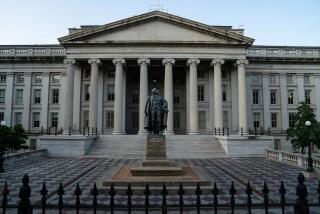Budget Office Forecasts Lower ’89 Deficit, No Automatic Cuts
- Share via
WASHINGTON — The Congressional Budget Office on Friday forecast a lower federal deficit for fiscal 1989 and predicted that the red-ink figure to be announced next week by the White House will not trigger automatic spending cuts in most government programs on the eve of national elections.
Faster-than-expected economic growth in the first half of 1988 improved the budget outlook, Acting CBO Director James L. Blum said in releasing the office’s late August advisory report to Congress.
While economic growth is expected to taper off in the last six months of the year, Blum said, CBO analysts foresee steady expansion at a 2.5% annual rate through 1989, with inflation rising slightly from 4% to 5% and the jobless rate holding at 5.5%.
The CBO’s estimated growth rate is somewhat lower than the Reagan Administration has assumed for its budget projections but higher than the average forecast by private economists, the budget office said in a statement.
Gramm-Rudman Law
Under the revised Gramm-Rudman deficit-reduction law, automatic cuts in spending would begin if the federal deficit to be estimated next Thursday by the White House’s Office of Management and Budget exceeds $146 billion.
Blum said he expects the OMB to project red-ink spending of about $144 billion, thus narrowly avoiding sequestration of funds already approved by Congress for the fiscal year starting Oct. 1.
The CBO estimated that the Gramm-Rudman deficit would be $153 billion in the next fiscal year, enough to trigger instant spending cuts. Blum implied, however, that it was a relatively meaningless number because the law gives the OMB exclusive power to decide the size of the deficit and thus determine if sequestration will occur.
“All indications are that OMB will come in below the trigger point,” Blum said. The figure will be lower because of differences with the CBO in estimating the amount of taxable income, the level of interest rates and the speed at which defense funds will be spent, he added.
“No one wants to have a sequestration this year--neither the Administration nor Congress,” he said, obviously mindful of politicians’ hopes of avoiding an event that would be likely to antagonize voters before they go to the polls in November.
Useful as ‘Benchmark’
The CBO calculations, he said, would be useful to Congress and economic analysts as a “benchmark” to evaluate the soundness of OMB’s estimate.
But the CBO director said that another estimate of the deficit, due by mid-October from the OMB, might be a “very tight squeeze.”
The law requires across-the-board reductions in outlays, with the exception of Social Security payments and some other programs, if the OMB estimate of the deficit exceeds $110 billion for fiscal 1990, $74 billion for fiscal 1991 and $38 billion for fiscal 1992. A balanced budget is mandated for fiscal 1993 under the law.
Blum said, however, that the latest CBO projections point to a deficit of $136 billion for 1990, dropping slowly to $121 billion in 1993 when the deficit is supposed to be eliminated.
“Budget deficits of this size and our low savings rates are quite troublesome,” Blum said. “It means we must rely on foreign investment to finance the debt. Most analysts would prefer a tighter money policy.”
Even so, he added, cutting the deficit to $110 billion in fiscal 1990 seems much more possible now than it did even a year ago.
More to Read
Get the L.A. Times Politics newsletter
Deeply reported insights into legislation, politics and policy from Sacramento, Washington and beyond. In your inbox twice per week.
You may occasionally receive promotional content from the Los Angeles Times.










